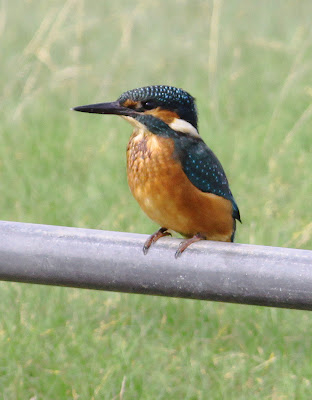Yet another sluggish start led me to think the morning would lead to a lack of notebook entries and little substance to today’s blog. Slowly but surely birds appeared whereby I recorded a little visible migration, saw the first warbler of the Spring and then found my first nest of 2014.
In the darkness I stopped at Lane Ends to count the Little Egrets in the roost - 47 birds scattered through the tall trees. For readers who don’t know Pilling, or the roosting habits of the Little Egret, the roost is situated within a public amenity area of pools and walkways, the birds spending the night in the safety of tall trees on an island of one of the small lakes. It’s quite a sight to see so many ghostly egrets in one location but difficult to take photographs with the birds fairly well distributed in the vegetation. They also vacate the roost in the half light of pre-dawn as they fly off to daytime feeding spots.
It’s no good planning to see Barn Owls, they invariably don’t turn up in the anticipated spot or when they’re meant to; much better to let one happen. After the egrets I checked a “regular” owl spot with camera at the ready but no Barn Owls appeared, so I motored on up to Cockerham and Braides Farm.
Here was quiet with just 60+ Golden Plover, 20+ Lapwing, 6 Curlew and 1 Grey Heron for my troubles.
Grey Heron
Passing Damside I noted both Kestrels in attendance near the regular nest box. Things also picked up at Fluke Hall. On the flooded maize at least 4 Lapwings were in tumbling display mode and 40+ others moving about the wet areas. Also, 70+ Redshanks feeding and one or more birds in both calling display flight and ground chasing. 7 Dunlin and 5 Curlew completed the waders with 30+ Shelduck and 2 Little Egrets in attendance.
Lapwing
Redshank
The sea wall gave the best count for a while of Pink-footed Goose at 750+, with both pipits and wagtails flying north across Morecambe Bay - 15+ Meadow Pipit and separate gangs of 15, 8 and then 5 Pied Wagtails. Several Skylarks in territorial song, mental notes made to check each location in more detail very soon. On and about the wildfowler’s pools I found an eclectic mix of 2 Pintail, 1 Green Sandpiper, 1 Buzzard, 1 Linnet, 2 Greenfinch and the third Kestrel of the morning.
Pintail
The walk along Fluke Hall Lane was for change a pleasant one, breeze and bluster-free, a rare opportunity of recent winter days to listen out for birds without the rustle and rush of swaying trees and falling branches.
There was a Chiffchaff singing from a garden, a regular spot of recent years but away from the denser woodland; Goldfinches, Tree Sparrows and Long-tailed Tits along the hedgerow, and when I reached the woodland the single “chick” call of a Great-spotted Woodpecker. From tall conifers I heard the contact calls of Siskins and then straining my neck almost vertically I could see four or maybe five of the tiny, fork-tailed finches moving through the dark branches above.
Chiffchaff
In the wood a pair of Long-tailed Tits quickly gave the game away, nest building in the fork of a roadside hawthorn, the nest in the early construction stage but with the pair constantly toing and froing with beaks full of nest material.
Long-tailed Tits construct their nest as a domed structure of moss woven with cobwebs and hair covered on the outside with camouflaged greyish/white lichen. I took a few pictures through the maze of branches where within in a few short weeks of vegetation growth the nest will become totally invisible.
Long-tailed Tit
Nest of Long-tailed Tit (under construction)
Nest of Long-tailed Tit (partly constructed)
A rewarding end to a fine morning’s birding, as when I later checked my notebook there were over 40 species recorded, much of the everyday stuff like Dunnocks, Robins, Wrens and Blackbirds omitted from the above.
Please now excuse me as I must go online and record my first Nest Record of 2014, but fear not there's more soon.
Please now excuse me as I must go online and record my first Nest Record of 2014, but fear not there's more soon.
And remember, you read it on Another Bird Blog first.
Linking today to Stewart's World Bird Wednesday.
Linking today to Stewart's World Bird Wednesday.















































































